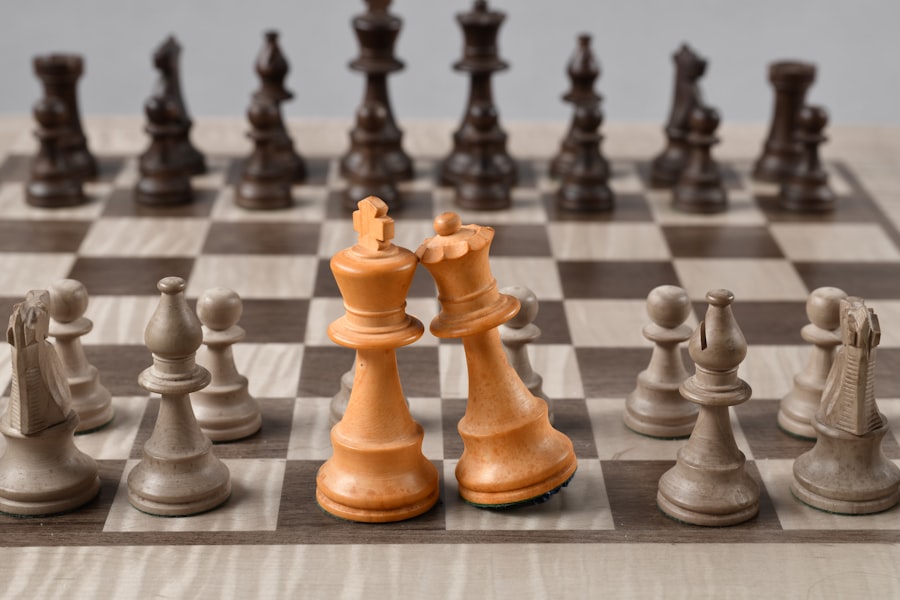Download links
How to install Mastering the Art of Chess Strategy APK?
1. Tap the downloaded Mastering the Art of Chess Strategy APK file.
2. Touch install.
3. Follow the steps on the screen.
Description
Chess strategy is a multifaceted discipline that encompasses a variety of principles and concepts aimed at achieving victory on the board. At its core, chess strategy involves the long-term planning and positioning of pieces to create advantageous situations while simultaneously thwarting the opponent’s plans. One of the fundamental aspects of chess strategy is the concept of control.
Controlling the center of the board is paramount, as it allows for greater mobility and influence over the game. The central squares—d4, d5, e4, and e5—serve as critical battlegrounds where both players vie for dominance. By occupying or contesting these squares, players can launch attacks more effectively and respond to threats with greater flexibility.
Another essential element of chess strategy is piece coordination. Each piece has its unique strengths and weaknesses, and understanding how to harmonize their movements can lead to powerful combinations and tactical opportunities. For instance, rooks are most effective when they are connected and can support each other, while bishops thrive on open diagonals where they can exert pressure from a distance.
Developing a keen awareness of how pieces interact with one another allows players to create threats that are difficult for opponents to counter. Additionally, players must be mindful of pawn structure, as it can dictate the flow of the game. Weak pawns can become targets for attack, while strong pawn formations can provide a solid foundation for launching an offensive.
Key Takeaways
- Understanding the basics of chess strategy is crucial for developing a strong foundation in the game.
- Developing a strong opening repertoire is essential for gaining an early advantage and controlling the game.
- Creating a solid middle game plan involves understanding key principles such as piece activity, pawn structure, and king safety.
- Mastering endgame techniques is important for converting advantages into wins and saving difficult positions.
- Utilizing tactical and positional skills is necessary for finding the best moves and exploiting weaknesses in the opponent’s position.
- Improving decision making and time management is crucial for making the most of limited time and maximizing the chances of success in a game.
Developing a Strong Opening Repertoire
A well-structured opening repertoire is crucial for any chess player aspiring to improve their game. The opening phase sets the tone for the entire match, establishing piece development, control of the center, and overall strategic direction. Players should familiarize themselves with a variety of openings to ensure adaptability against different opponents.
By studying these openings in depth, players can understand the underlying principles and typical middlegame positions that arise from them. In addition to learning specific openings, players should also focus on understanding the key ideas behind their chosen repertoire.
This includes recognizing common traps, tactical motifs, and strategic plans associated with each opening. For instance, in the King’s Indian Defense, Black often aims for a pawn storm on the kingside while maintaining a solid structure in the center. By internalizing these concepts, players can navigate the complexities of the opening phase with confidence and purpose.
Furthermore, it is beneficial to analyze games played by grandmasters who employ similar openings, as this can provide valuable insights into advanced strategies and techniques.
Creating a Solid Middle Game Plan

The middle game is where the true essence of chess strategy comes to life. It is during this phase that players must transition from the opening principles into concrete plans based on the unique characteristics of their position. A solid middle game plan often revolves around identifying strengths and weaknesses in both one’s own position and that of the opponent.
For example, if a player has a strong pawn structure and active pieces, they may choose to launch an attack against the opponent’s king or create weaknesses in their pawn formation. Conversely, if faced with a cramped position, a player might focus on improving piece activity and seeking counterplay. Central to crafting an effective middle game plan is the ability to evaluate positions accurately. This involves assessing material balance, piece activity, king safety, and pawn structure. Players should ask themselves critical questions: Are my pieces well-coordinated?
Is my king safe from potential threats? Are there weaknesses in my opponent’s position that I can exploit? By systematically analyzing these factors, players can formulate plans that align with their strengths while targeting their opponent’s vulnerabilities.
Additionally, it is essential to remain flexible; as the game evolves, so too should one’s strategy. Adapting to changing circumstances can often be the difference between victory and defeat.
Mastering Endgame Techniques
| Technique | Definition | Example |
|---|---|---|
| Zugzwang | Forcing the opponent to make a disadvantageous move | Forcing the opponent to move their king into a vulnerable position |
| Opposition | Positioning the kings directly across from each other with an odd number of squares between them | Using the opposition to advance the king and gain space |
| Triangulation | Wasting a move to put the opponent in a worse position | Using triangulation to force the opponent to move their king away from a key square |
The endgame represents a unique phase in chess where fewer pieces remain on the board, and precise calculation becomes paramount. Mastering endgame techniques is essential for converting advantages into victories or salvaging draws from seemingly lost positions. One of the foundational concepts in endgame play is understanding key theoretical positions, such as king and pawn versus king or rook versus king and pawn scenarios.
Familiarity with these basic endgames allows players to navigate complex situations with confidence and clarity. In addition to theoretical knowledge, practical endgame skills involve recognizing winning techniques and applying them effectively. For instance, knowing how to create passed pawns or utilize opposition can significantly enhance a player’s chances of success in endgame scenarios.
Furthermore, players should practice converting material advantages into wins by understanding how to coordinate their pieces effectively in simplified positions. This includes learning how to use rooks effectively in endgames, as they are often crucial in supporting pawns or cutting off the opponent’s king.
Utilizing Tactical and Positional Skills
Tactics and positional understanding are two sides of the same coin in chess strategy. Tactical skills involve recognizing short-term opportunities for gaining material or achieving checkmate through combinations and calculations. Common tactical motifs include forks, pins, skewers, and discovered attacks.
Players must develop their ability to spot these patterns quickly during games, as tactical opportunities often arise unexpectedly and can turn the tide of a match in an instant. Regular practice through puzzles and tactical exercises can sharpen this skill set significantly. On the other hand, positional skills focus on long-term strategic considerations that influence the overall flow of the game.
This includes understanding pawn structures, piece placement, and controlling key squares or files. A player with strong positional skills can often maneuver their pieces into optimal positions even when immediate tactical opportunities are not present. For example, controlling open files with rooks or placing knights on outposts can create enduring advantages that may not be immediately apparent but will pay dividends as the game progresses.
Balancing tactical awareness with positional understanding allows players to navigate complex positions more effectively and make informed decisions that align with their overall strategy.
Improving Decision Making and Time Management

Evaluating Positions
This involves assessing the position by asking critical questions: What are my opponent’s threats? What are my best moves? How do I improve my position?
Time Management
By following this structured approach, players can reduce impulsive decisions driven by emotions or time pressure. Time management is equally important in chess, particularly in faster time controls where every second counts. Players must learn to balance their time effectively between critical moments that require deep calculation and routine moves that can be played more quickly.
Mastering Chess Strategy
In conclusion, mastering chess strategy requires a comprehensive understanding of various elements ranging from openings to endgames, as well as tactical awareness and effective decision-making skills. By delving into each aspect with dedication and practice, players can elevate their game and navigate the complexities of chess with confidence and skill.
If you are a fan of strategy games like chess, you may also enjoy reading about the mobile game Jurassic World Alive. This game combines elements of strategy and adventure as players collect dinosaurs and battle against other players in real-time. To learn more about this exciting game, check out the article here.
FAQs
What is chess?
Chess is a two-player strategy board game that is played on an 8×8 grid. It is one of the most popular and enduring games in the world, with a rich history dating back over 1500 years.
How is chess played?
Chess is played on a square board divided into 64 squares, with each player starting with 16 pieces: one king, one queen, two rooks, two knights, two bishops, and eight pawns. The objective of the game is to checkmate the opponent’s king, which means putting the king into a position where it cannot escape capture.
What are the basic rules of chess?
Each type of piece moves in a specific way, and players take turns moving their pieces across the board. The game ends when one player’s king is in checkmate, or when a stalemate is reached. There are also special moves in chess, such as castling and en passant.
What are the benefits of playing chess?
Chess has been shown to have numerous cognitive benefits, including improving memory, concentration, problem-solving skills, and strategic thinking. It is also a great way to improve patience and decision-making abilities.
What is the history of chess?
Chess originated in India around the 6th century and spread to Persia, where it became known as “shatranj.” It then spread to Europe and evolved into the game we know today. Chess has a rich and fascinating history, with many famous players and memorable games.





